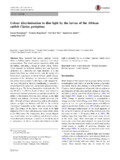Colour discrimination in dim light by the larvae of the African catfish Clarias gariepinus
Share
Abstract
Many demersal fish species undergo vertical shifts in habitats during ontogeny especially after larval metamorphosis. The visual spectral sensitivity shifts with the habitat, indicating a change in colour vision. Colour vision depends on sufficient ambient light and becomes ineffective at a particular low light intensity. It is not known how fishes see colour in dim light. By means of a behavioural experiment on larval African catfish Clarias gariepinus in the laboratory, we determined colour vision and colour discrimination in dim light. Light-adapted larvae were subjected to classical conditioning to associate a reward feed with a green or a red stimulus placed among 7 shades of grey. The larvae learned this visual task after 70 and 90 trials. A different batch of larvae were trained to discriminate between green and red and then tested for the ability to discriminate between these colours, as the light intensity was reduced. The larvae learned this visual task after 110 trials in bright light and were able to discriminate colours, as light was dimmed until 0.01 lx, the minimal illuminance measurable in this study, and similar to starlight. The retinae of the larvae were found to be light adapted at 0.01 lx; thus indicating cone-based colour vision at this illuminance. For comparison, three human subjects were tested under similar conditions and showed a colour vision threshold at between 1.5 and 0.1 lx. For the larvae of C. gariepinus, the ability of colour discrimination in dim light is probably due to its retinal tapetum, which could increase the sensitivity of cones.
Suggested Citation
Kawamura, G., Bagarinao, T., Hoo, P. K., Justin, J., & Lim, L. S. (2017). Colour discrimination in dim light by the larvae of the African catfish Clarias gariepinus. Ichthyological Research , 64(2), 204-211. https://doi.org/10.1007/s10228-016-0557-0
Subject
Collections
- AQD Journal Articles [1249]

